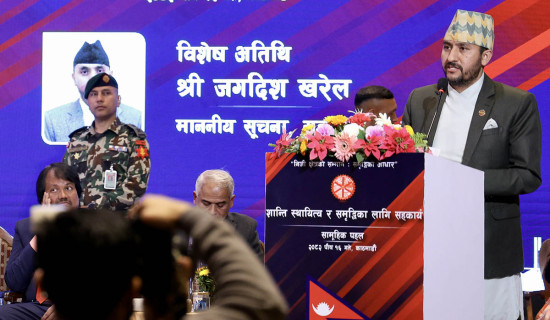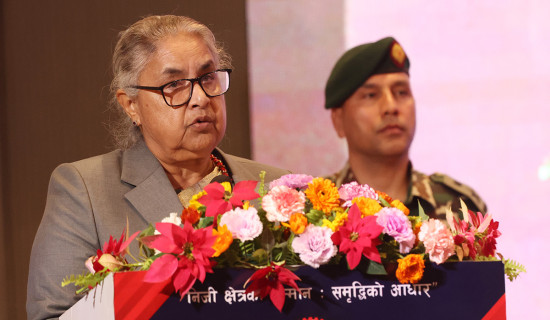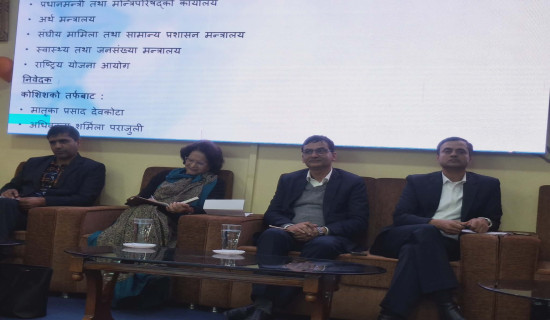- Wednesday, 31 December 2025
Transformative Potential Of BRI Projects
The Belt and Road Initiative (BRI), launched by China in 2013, is an ambitious global development strategy aimed at enhancing connectivity and cooperation among multiple countries across Asia, Europe, and Africa. Nepal, a landlocked country nestled between India and China, joined the BRI in 2017 with hopes of transforming its infrastructure and boosting its economy. The BRI can help Nepal achieve its dream of modernisation, focusing on key areas such as infrastructure, trade, tourism, and energy. Nepal’s strategic location places it at a unique crossroads. Historically, Nepal has been influenced by both of its giant neighbours culturally, economically, and politically. This unique position has often left Nepal balancing its foreign policy delicately between these two powerful nations. The BRI provides Nepal with an opportunity to leverage its geographical position to become a transit hub between South Asia and China, facilitating greater economic integration and regional connectivity.
Nepal’s participation in the BRI is significant not only for its potential economic benefits but also for its geopolitical implications. By engaging with China through the BRI, Nepal signals its intent to diversify its economic partnerships and reduce its over-reliance on India. This move could potentially rebalance regional power dynamics and provide Nepal with greater diplomatic say in its international relations. However, this comes with the necessity of managing the delicate relationship with India, which has expressed reservations about the BRI.
Infrastructure development
One of the primary benefits of the BRI for Nepal is the potential for significant infrastructure development. The BRI projects include roads, railways, and airports crucial for enhancing connectivity within the country and with its neighbours. The proposed railway line connecting China’s Tibet Autonomous Region (TAR) with Nepal’s capital, Kathmandu, and further extending to Lumbini, holds the promise of reducing transportation costs and time, thereby facilitating trade and tourism. The extension of the Qinghai-Tibet railway to Nepal is expected to modernise Nepal’s transportation infrastructure, making it more efficient and reliable. Improved road networks under the BRI framework will not only connect remote areas within Nepal but also integrate it into the larger regional road network, enhancing trade routes and economic corridors.
The BRI aims to create a vast network of trade routes that will benefit all participating countries. For Nepal, the initiative promises to open new markets for its products and create a more balanced trade relationship with China. Nepal has the potential to export agricultural products such as rice, wheat, and maize to China, particularly to regions like Tibet which have lower agricultural productivity. Similarly, livestock products and certain manufactured goods could find a market in the Chinese provinces connected through the BRI. The BRI can attract Chinese investments in Nepal’s industrial sector, helping to develop industries such as cement, hydropower, and tourism. The establishment of special economic zones and industrial parks with Chinese collaboration can significantly boost Nepal’s industrial output and employment.
Tourism is a vital sector for Nepal, known for its rich cultural heritage and natural beauty. The BRI can enhance Nepal’s tourism potential by improving infrastructure and connectivity. Improved transportation links with China will likely lead to an increase in Chinese tourists visiting Nepal. The development of tourism infrastructure such as hotels, resorts, and heritage sites can cater to this influx. The BRI also promotes people-to-people bonds, which can lead to increased cultural exchange and mutual understanding between Nepal and China. Joint cultural projects and events can enhance the cultural ties and cooperation between the two nations.
Energy is another critical area where the BRI can play a transformative role in Nepal’s development. Nepal has vast hydropower potential, and Chinese investment and technology can help harness this resource efficiently. Collaboration in the hydropower sector can lead to the development of large-scale hydropower projects, providing a stable and sustainable energy source for Nepal and even enabling electricity exports to neighbouring countries. The BRI framework also includes initiatives for renewable energy development. Solar and wind energy projects can be developed in partnership with Chinese firms, contributing to Nepal’s energy security and reducing reliance on fossil fuels. Meanwhile, it also presents certain challenges that need to be addressed. One of the significant concerns is the risk of debt dependency. Nepal must ensure that the loans and investments under the BRI are managed prudently to avoid falling into a debt trap. This requires transparent governance and effective utilisation of funds to ensure that infrastructure projects are completed on time and within budget.
Balance foreign policy
Additionally, Nepal must navigate its relationships with both China and India carefully. While engaging with the BRI, it is crucial for Nepal to maintain a balanced foreign policy that does not alienate India. Balancing these relationships is key to ensuring that Nepal maximises its benefits from the BRI while maintaining regional stability. Moreover, the focus should be on sustainable and inclusive development. Ensuring that the benefits of BRI projects reach all segments of society, including marginalised communities, is essential for long-term stability and growth. This requires a comprehensive approach to development that includes not just infrastructure but also social and economic programmes that address inequality and promote social cohesion. Nepal’s government must work closely with local communities and civil society to ensure that development projects are inclusive and that they do not lead to social displacement or environmental degradation.
The BRI holds the potential to transform Nepal by ensuring the infrastructure development, investment, and connectivity necessary for its modernisation and prosperity. The success of this endeavour will depend on strategic planning, effective implementation, and maintaining a balanced approach in its international relations. Nepal’s engagement with the BRI symbolises a step towards a brighter future, one where it can harness its geographical advantages and historical ties to emerge as a significant player in the regional and global economy.
(Rana is the former president of the Hong Kong-Nepali Federation.)













-original-thumb.jpg)


